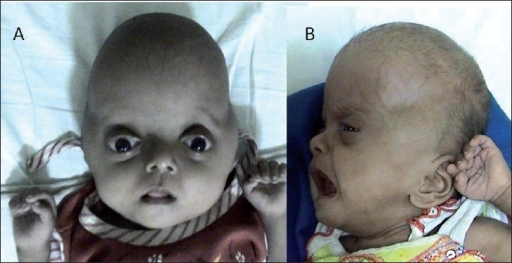Pfeiffer Syndrome Type 1

Pfeiffer syndrome type 1 (PS1) is a mild to moderately severe type of Pfeiffer syndrome (PS; see this term), characterized by bicoronal craniosynostosis, variable finger and toe malformations, and in most cases, normal intellectual development.
Epidemiology
The exact annual incidence of this form of PS is not known but the incidence of all forms of PS is 1/100,000.
Clinical description
PS1 concerns patients with an overall mildly to moderately severe clinical picture and a generally favorable course. Patients present with bicoronal craniosynostosis, moderate to severe mid-face hypoplasia, broad medially deviated thumbs and halluces, and variable brachydactyly and syndactyly. Associated features may include bilateral symmetrical hearing loss and hydrocephalus. Milder phenotypes typically allow for normal brain development, limiting the number of associated complications. Intelligence is usually normal or just below average. In mild cases, the need for corrective surgery is also limited. Congenital airway compromise is not a complication in type 1 patients. PS1 has a much more favorable prognosis than PS type 2 or type 3.
Etiology
PS1 is most commonly caused by mutations in the FGFR2 gene (10q25.3-q26), and in rare instances by mutations in the FGFR1 gene (8p11.23-p11.22).
Genetic counseling
Pfeiffer syndrome follows an autosomal dominant pattern of inheritance, observed primarily in non-severe cases compatible with long-term survival. Genetic counseling for affected families is recommended.
Prognosis
Due to decreased need for extensive corrective surgery and essentially normal intellectual development, overall prognosis in PS1 is much more favorable than in Pfeiffer syndrome type 2 or type 3.